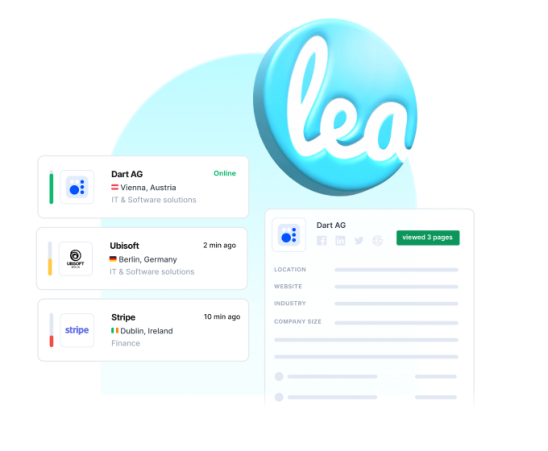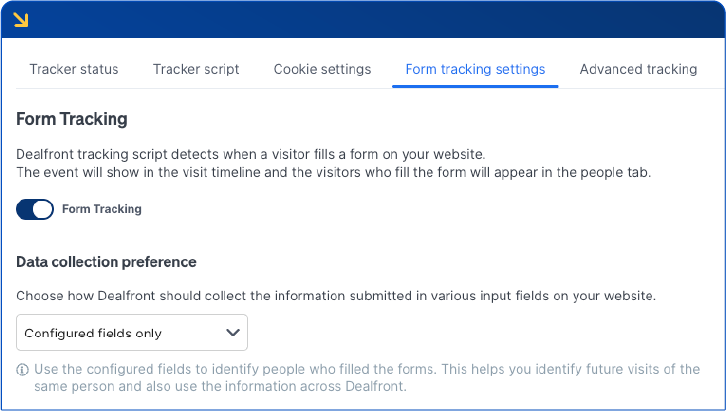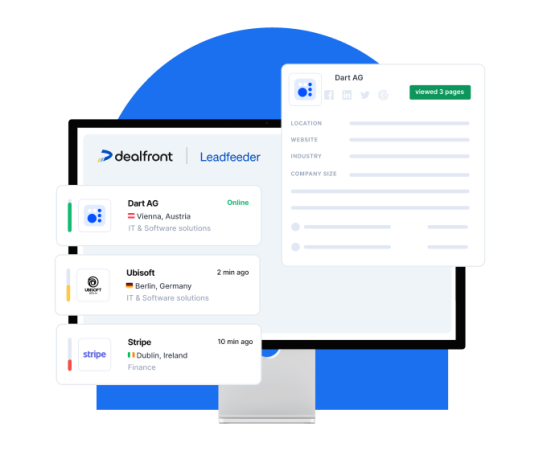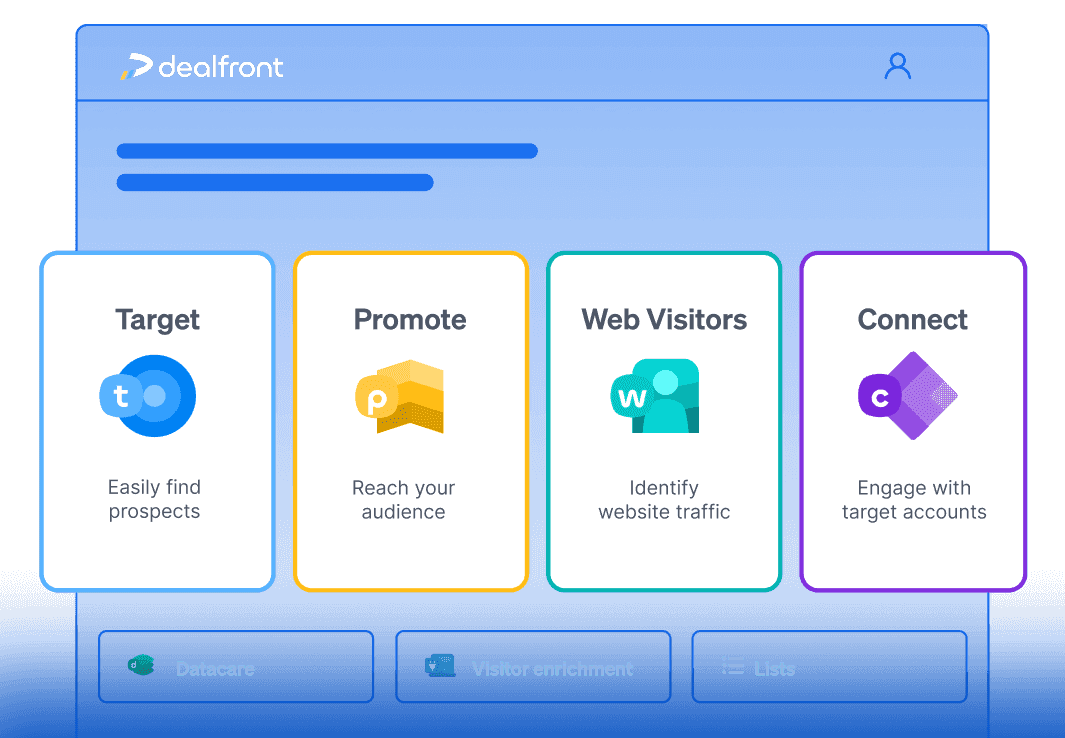In the world of content marketing, there's an ongoing debate about whether to gate or ungate content. Content gating refers to the practice of requiring users to provide their contact information before accessing valuable content, while ungating involves making content freely available without any barriers.
You’re here because you’ve asked yourself:
Do I lose leads when I ungate my content?
How do I keep my pipeline full of leads for my sales team?
In this piece, we’ll be exploring those questions, and more, so you can make informed decisions for your business without the fear of losing out.
Understanding gated vs. ungated content
So what exactly is gated content? When visitors land on your website, they'll encounter a call-to-action (CTA) or a pop-up that presents them with an enticing offer (often information). In exchange for their information, they gain access to the content.
This CTA or pop-up can guide them to a landing page, where they'll find more details about the content on offer. It's worth noting that with inbound marketing, gated content is typically free and doesn't hide behind a paywall. To unlock the content, users merely need to provide their contact information, usually their name, phone number, and/or email address.
Typically, the purpose of gated content is lead generation. Marketers craft targeted content to attract potential leads. Businesses don't use gated content for brand awareness or visibility campaigns because the nature of hidden content doesn't generate high traffic.
Ungated content is basically the opposite of all of that. You can opt to offer downloadable content without requiring your visitor to fill in a form or leave information with you in some way. The big concern here of course is that marketing teams don’t have a way of seeing who is accessing the content which means, there are no leads to track. But, before you completely write off offering ungated content there are a few things that work in its favor.
So how do you choose what’s right for your business?
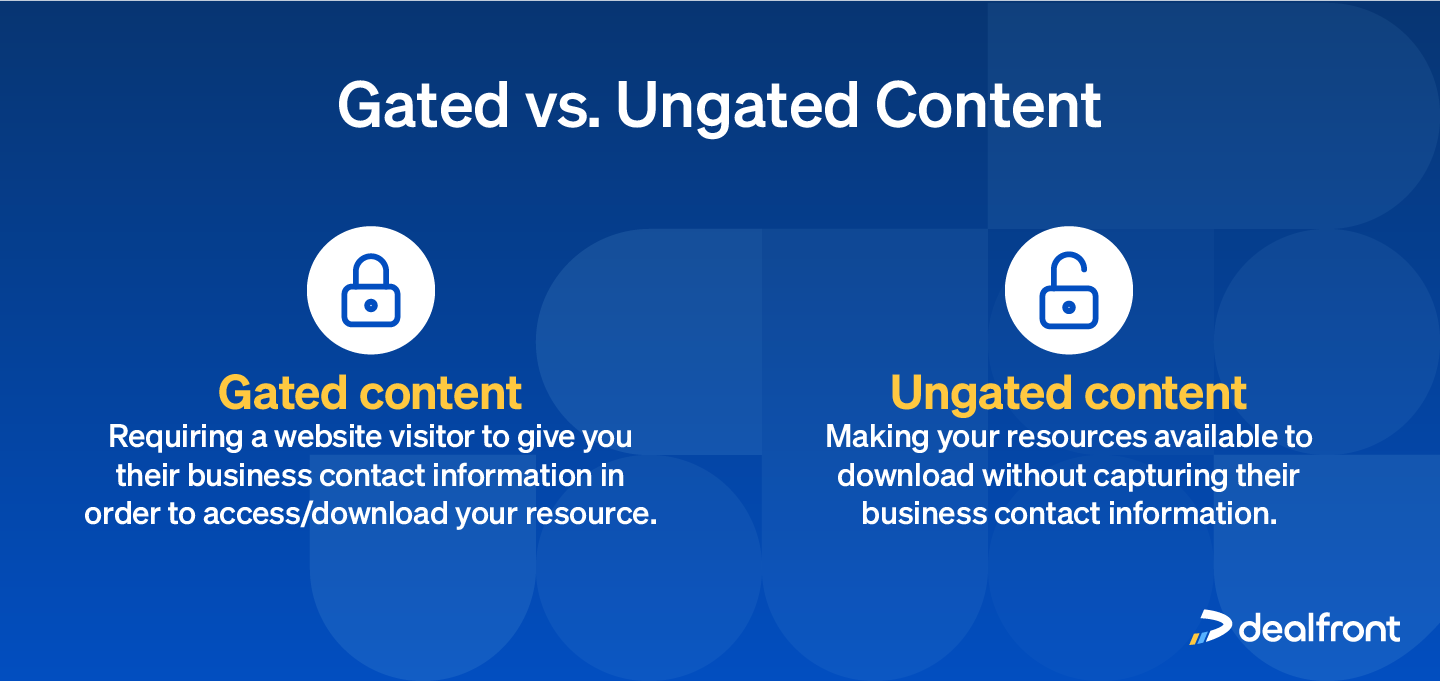
Pros of gating content
Aids your lead generation
You can increase the number of visitors to your site who express interest in being contacted. Different types of content can provide a steady flow of prospects to your sales team and attract potential customers within your target audience.
Enhances your customer segmentation
Get demographic information on your website visits to refine your buyer personas, allowing you to target ideal customers more accurately.
Eases direct communication
By getting a prospect’s contact information, you can be the one reaching out with email campaigns. This way you don’t have to rely on the prospect to initiate contact with you.
Main takeaway: Gated content provides you with additional opportunities to engage with your audience on your terms and motivate them to take action.
Cons of gating content
Reduced reach
Getting backlinks can be difficult because website owners are less likely to link to a page with little content. They may also not want to share content that requires their audience to give their information to your company.
Limited SEO benefits
Fewer backlinks equals reduced SEO rankings. And when gating content, you “no-index” the page it’s on telling Google you don’t want the search engine to crawl it.
User friction
People are skeptical about handing over their information, even if the content promises to be good. Gated content also interrupts the flow of your visitor’s search for information.
Main takeaway: Gated content reduces your reach, limits SEO benefits and creates barriers between you and your prospects.
Pros of ungating content
Increased visibility
You’ll experience higher engagement, reach and traffic when your content isn’t hidden behind a lead capture form. Why? Because you’ve removed the barrier to your prospect finding the answers they need.
Website traffic and brand awareness
More content means search engines have more to crawl and rank, leading to more people finding that content. The more people that find your content, the higher your brand visibility.
Main takeaway: Ungated content brings higher engagement, traffic and brand awareness. It also builds trust because the customer gets the answers to their questions without filling in a form.
Cons of ungated content
Monetization will be harder
Freely accessible content means there is no value exchange, making it difficult to generate direct revenue from the content itself.
Competitors can also access your content
Your competition could use your content as inspiration or to mimic your position and messaging. They can also use it to take advantage of gaps in your content strategy.
Unique selling propositions
Expanding on the previous point, your content proliferating across the web just with different branding means that you’ll lose what makes you unique.
Main takeaway: Ungated content makes it hard to generate revenue, and when competitors can also access your content to mimic you, you lose your unique positioning.
The case for both gated and ungated content
Ultimately, you want to find the middle ground between creating value for your business and for your customer. Sure, collecting prospective customers’ information is essential in lead generation, but you’re also creating a barrier between you and their need for information.
On the other hand, you can use the information you collect to provide a more personalized outreach because you can see what they’re interested in. This in turn builds the beginning of trust between you and your prospects, ideally turning them into customers!
What can you do to make sure your lead generation doesn’t stagnate, and also not turn away prospects by constantly asking them to fill in forms? Because when you have the right tools to support your strategies, you don’t really have to choose.
Enter Dealfront's Leadfeeder form tracking and file tracking
What is form tracking?
Form tracking lets you identify companies that visit your website and also gain insight into all their visits to your website. This valuable intelligence allows you to track the past and future behavior of visitors when they submit a form.
How does form tracking work in Dealfront?
Dealfront’s form tracker feature can track any form submission on your website and can help with the following:
It can identify leads that displayed interest in your offerings when they submitted a form.
You get insights into all past and future visits from the same account, allowing you to offer a more personalized experience with your brand.
A form submit event is shown in your lead activity timeline when a submission is identified, so you won’t miss out on any opportunities.
By implementing Dealfront's form tracking, you gain valuable insights into account interactions on your website, allowing you to identify potential leads and optimize your sales and marketing efforts effectively.
Enabling form tracking
Here’s what you have to do to enable form tracking within Dealfront Leadfeeder:
In the platform, click on the Settings icon (the gear) and you’ll see 3 options.
Click Company and in the left-hand navigation, select under general “Website Tracker”.
You should now see this:
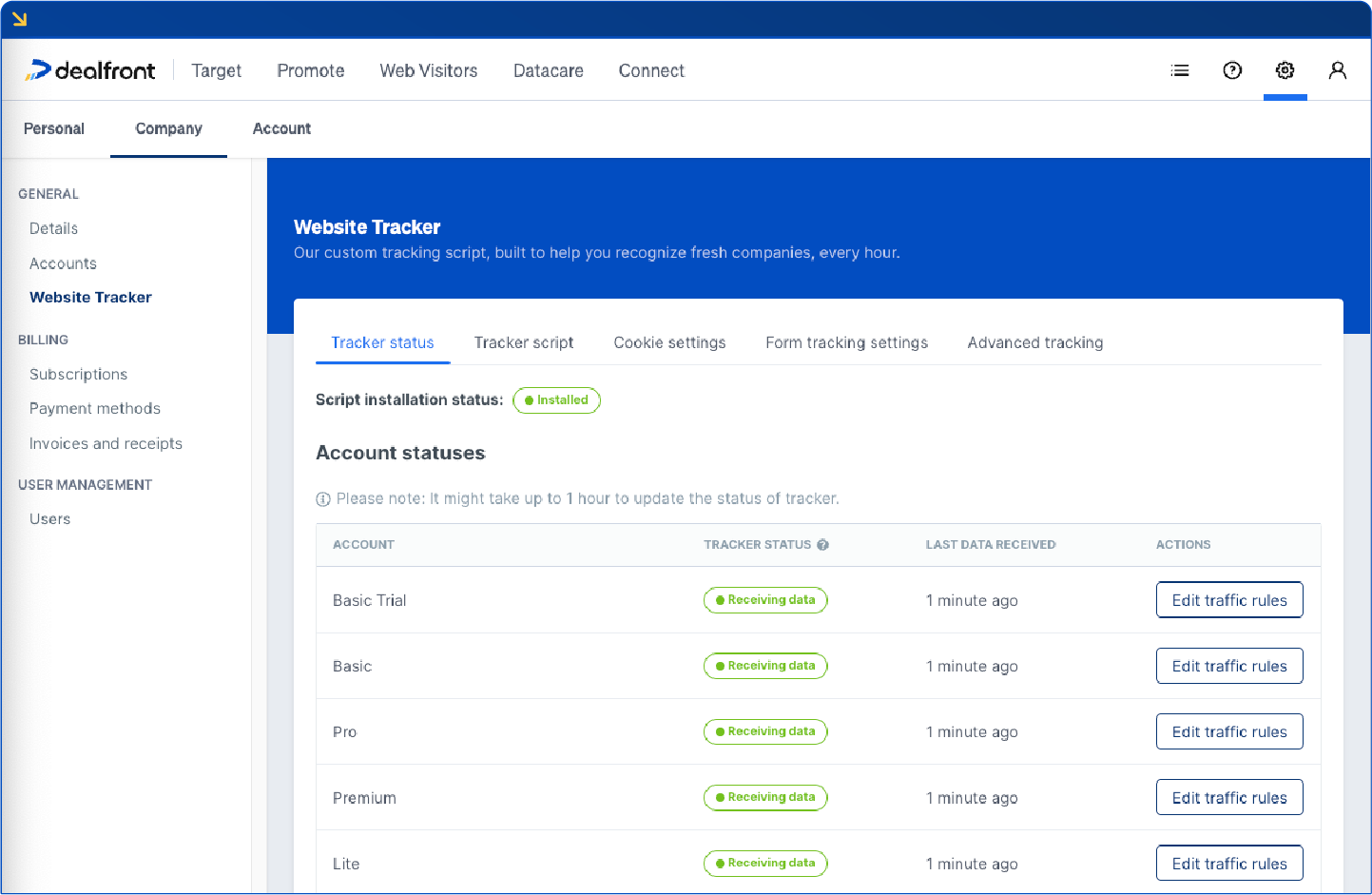
Now, click on Form tracking settings and click the Form Tracking button to activate it.
The Data collection preference allows you to define how the Dealfront collects information. Configured fields only means you can select the parameters you want to collect. This can be things like company email or phone number. There’s also the All input field and the Disabled options.
Now, click on Form tracking settings and click the Form Tracking button to activate it.
![Web Visitors Form Tracking]()
The Data collection preference allows you to define how the Dealfront collects information. Configured fields only means you can select the parameters you want to collect. This can be things like company email or phone number. There’s also the All input field and the Disabled options.
What is file tracking?
File tracking lets you identify the companies that have downloaded your ungated file, for example a .pdf or a .doc, despite them not entering any firmographic information.
How does file tracking work in Dealfront?
When you’ve activated file tracking in Dealfront, you can still find out which company downloaded your ungated content. The tracker script detects when a visitor downloads content from your website. You can select the specific type of files you’d like to track:

As you can see, there is a wide variety of file types that you can opt to track. To do that, you would create a custom feed within the tool with a filter such as “File Download is {File Name}”. Then, you can see which companies have downloaded it.
This next example shows how we track Dealfront pricing downloads. As you can see, 64 companies have downloaded it which makes them high intent leads. Why? We can assume that their interest in our pricing means they aren’t just superficially interested.
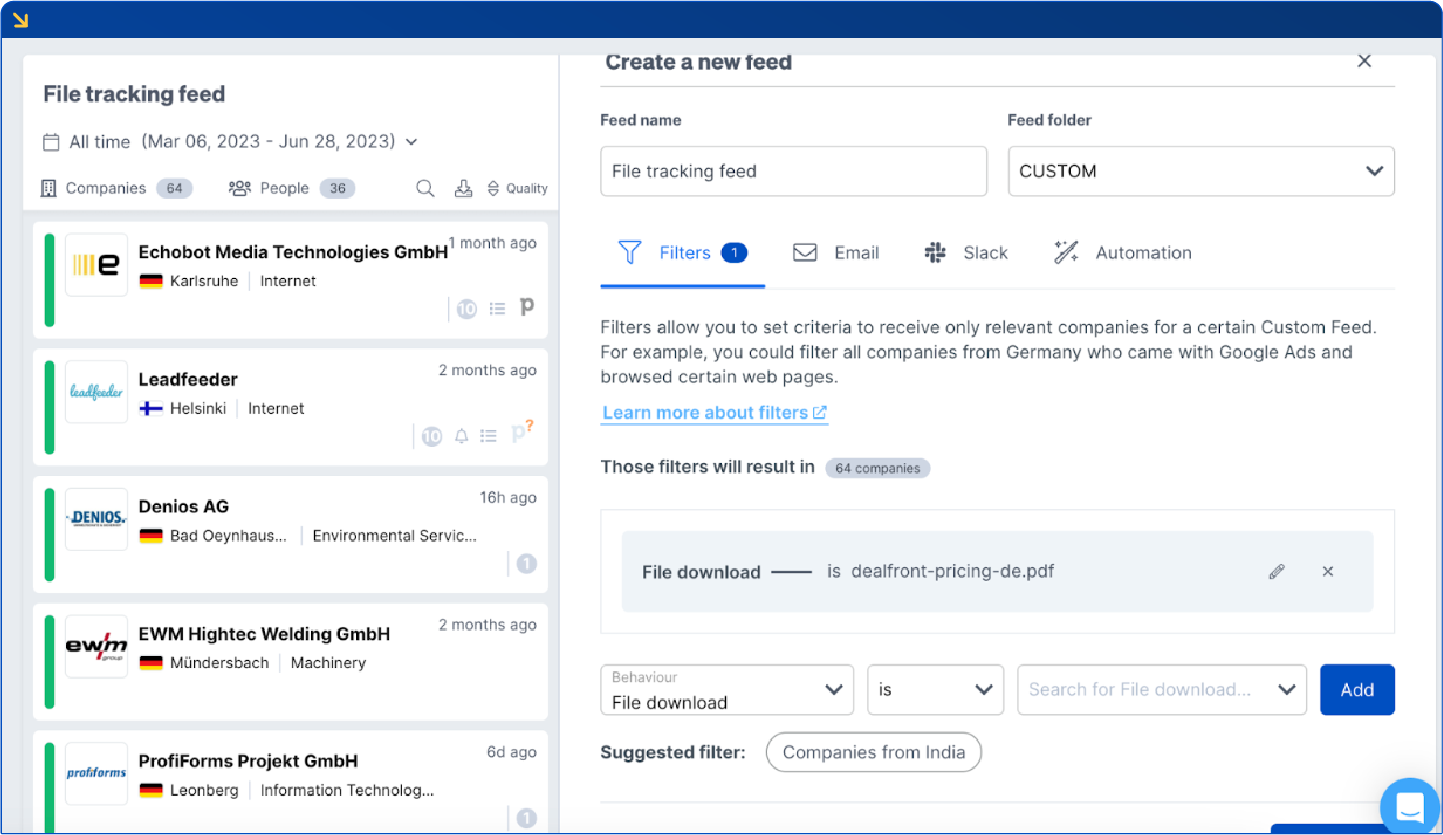
Apart from all the technical aspects of the tool, you may be concerned about data privacy and what that means for your customers. Is being able to discover company information compliant with data privacy regulations such as the GDPR?
Here’s a quick rundown of our platform in the context of data privacy:
Are the tools compliant with applicable privacy laws in the EU?
Disclaimer: The legal situation surrounding privacy laws in the EU is complex and cannot be comprehensively covered in this article. This piece is not intended as and cannot replace legal advice but is rather a suggestion to inform yourself further. In case of doubt, please seek advice from a legal specialist.
Our tools can be used in a GDPR and privacy compliant way. With regard to the underlying processing activity, we operate as a data processor and you act as a data controller. This relationship is governed by our data processing agreement which you can download in our Privacy Center.
The activity of tracking IP addresses of web visitors in order to understand and identify what companies have visited clients’ websites can - in most cases - be based on legitimate interest (Article 6 (1) lit. f GDPR).
We can’t perform the required balancing of interest test for you. However, we can provide you with sufficient information to enable you to perform the required balancing of interest test:
If Leadfeeder is implemented on the website of a client, the following information is collected:
Source and Medium Source, Medium, Campaign, Keyword, if applicable (from UTMs or google analytics)
Visitor ID number (as set by a cookie, i.e. only in the cookie solution)
IP address
Visitor behavior (e.g. pages visited, time and date of visit, duration of visit)
No sensitive personal information is collected.
The data collected from the person visiting your website is limited to what is strictly necessary in order to be able to perform the processing activity.
The data is adequate, accurate and up to date.
People visiting your website have an easy way to object to the processing by installing and configuring appropriate ad-blockers or using no-script-plugins in their browser.
We process any personal data of your website visitors strictly only on behalf of you in a secure and separate data bucket.
Take a look at our GDPR information as well as our Privacy Center to learn more about the data security for both you and your customers. If you are interested in how the Leadfeeder technology works, and how to implement it with or without cookies, please read our Website Tracker help center article on data processing roles.
Gated vs. Ungated: The best of both worlds
The debate between gated and ungated content has been ongoing in the world of content marketing. But after looking at the pros and cons, we think it's clear that finding the balance between gated and ungated content is the way forward. Especially when you’re supported by the right tools.
Ungate your content to remove barriers your visitors may have when looking for information. Also, by unblocking your valuable information, you can increase visibility, drive higher website traffic, boost brand awareness, and increase content sharing. With ungated content, more people can access the information they need, and you position yourself as a thought leader and industry expert.
Gated content helps keep lead generation flowing and provides opportunities for direct, personalized communication. If you choose to ungate your content, you don’t have to fear losing out on leads with Dealfront’s website tracking capabilities.
The takeaway from all of this is that you need to offer the right combination of gated and ungated content to optimize your marketing strategies that in turn boosts your business results.

